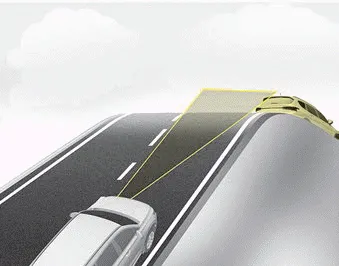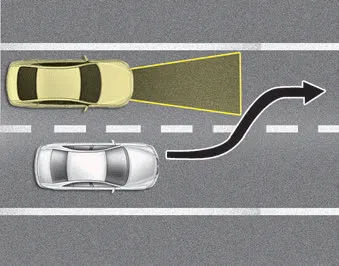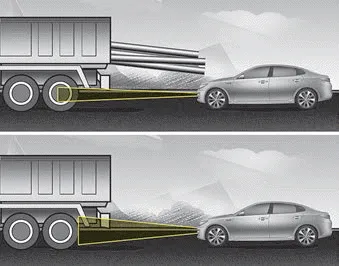Kia Rio: Forward Collision-Avoidance Assist (FCA) system (Radar type) / Limitation of the system
FCA system is designed to monitor the vehicle ahead through radar signals to warn the driver that a collision is imminent, and if necessary, apply emergency braking. In certain situations, the radar sensor may not be able to detect the vehicle ahead. In these cases, FCA system may not operate. The driver must pay careful attention in the following situations where FCA operation may be limited:
Detecting vehicles
The sensor may be limited when:
- The radar sensor is blocked with a foreign object or debris
- Inclement weather such as heavy rain or snow obscures the field of view of the radar sensor
- There is interference by electromagnetic waves
- There is severe irregular reflection from the radar sensor
- The radar sensor recognition is limited
- The vehicle in front is too small to be detected (for example a motorcycle, etc.)
- The preceding vehicle is a special purpose vehicle or a special shape of cargo loaded truck, or a trailer.
- The vehicle in front is driving erratically
- The vehicle is on unpaved or uneven rough surfaces, or roads with sudden gradient changes
- The vehicle is moving under ground level or inside a building
- The vehicle is driven near areas containing metal substances such as a construction zone, railroad, etc.
- The sensor recognition is suddenly changed after passing a speed bump.
- The vehicle is severely vibrating or shaking.
- The preceding vehicle is turning at a roundabout.
- The radar or sensor cover has been damaged.
- The vehicle is passing a tunnel, a tollgate, or a partially paved road.
- The radar sensor’s recognition is over its limitation.

- Driving on a curve
FCA system performance may be limited while driving on a curve. FCA system may not recognize the vehicle in front even if in the same lane. It may produce the warning message and the warning alarm prematurely, or it may not produce the warning message or the warning alarm at all. When driving on a curve, exercise caution, maintain a safe braking distance, and if necessary, depress the brake pedal to reduce your driving speed in order to maintain a safe distance.

FCA system may recognize a vehicle in an adjacent lane when driving on a curved road. In this case, the system may apply the brake. Always pay attention to road and driving conditions while driving. If necessary, depress the brake pedal to reduce your driving speed in order to maintain a safe distance. Also, when necessary, you may depress the accelerator pedal to prevent the system from unnecessarily decelerating your vehicle. Always check the traffic conditions around the vehicle.

- Driving on a slope
FCA system performance may be limited while driving upward or downward on a slope, and may not recognize a vehicle in front in the same lane. It may produce the warning message and the warning alarm prematurely, or it may not produce the warning message and the warning alarm at all.
When FCA system suddenly recognizes the vehicle in front while passing over a slope, you may experience sharp deceleration.
Always keep your eyes forward while driving upward or downward on a slope, and, if necessary, depress the brake pedal to reduce your driving speed in order to maintain a safe distance.

- Changing lanes
When a vehicle changes lanes in front of you, FCA system may not immediately detect the vehicle, especially if the vehicle changes lanes abruptly. In this case, you must maintain a safe braking distance, and if necessary, depress the brake pedal to reduce your driving speed in order to maintain a safe distance.

When driving in stop-and-go traffic, and a stopped vehicle in front of you merges out of the lane, FCA system may not immediately detect the new vehicle that is now in front of you. In this case, you must maintain a safe braking distance, and if necessary, depress the brake pedal to reduce your driving speed in order to maintain a safe distance.

- Recognizing the vehicle
If the vehicle in front of you has cargo that extends rearward from the cab, or when the vehicle in front of you has higher ground clearance, additional special attention is required. FCA system may not be able to recognize the cargo extending from the vehicle. In these instances, you must maintain a safe braking distance from the rearmost object, and if necessary, depress the brake pedal to reduce your driving speed in order to maintain distance.
WARNING - Testing FCA system
The FCA system may not operate in certain situations. Therefore, never test the operation of the FCA system using a person or object, as doing so may cause severe injury or even death.
WARNING - FCA system and Towing
Cancel FCA system in the User Settings on the LCD display, before towing another vehicle. While towing, the brake application may adversely affect your vehicle safety.
✽ NOTICE
In some instances, FCA system may be canceled when subjected to electromagnetic interference.
WARNING
- Use extreme caution when the vehicle in front of you has cargo that extends rearward from the cab, or when the vehicle in front of you has higher ground clearance.
- FCA system is designed to detect and monitor the vehicle ahead through sensor recognition. It is not designed to detect bicycles, motorcycles, or smaller wheeled objects such as luggage bags, shopping carts, or strollers.
- When replacing or reinstalling of front bumper or radar, have the vehicle inspected for the system check by an authorized Kia dealer.
When FCA is not working properly, FCA warning light ( ) will illuminate and the warning message (“Check FCA system”) will appear for a few seconds.
The cruise control system allows you to program the vehicle to maintain a constant speed without depressing the accelerator pedal. This system is designed to function above approximately 30 km/h (20 mph).
Other information:
Kia Rio 2017-2023 YB Service Manual: Immobilizer System
Schematic diagrams Circuit Diaram Description and operation Description The immobilizer system will disable the vehicle unless the proper ignition key is used, in addition to the currently available anti-theft systems such as car alarms, the immobilizer system aims to drastically reduce the rate of auto theft.
Kia Rio 2017-2023 YB Service Manual: Windshield Wiper-Washer Switch
Repair procedures Removal [BCM Type] 1. Disconnect the negative (-) battery terminal. 2. Remove the steering wheel. (Refer to Steering System - "Steering Wheel") 3.
Categories
- Manuals Home
- Kia Rio Owners Manual
- Kia Rio Service Manual
- Check tire pressure
- If you have a flat tire (with Tire Mobility Kit)
- System setting and activation
- New on site
- Most important about car
